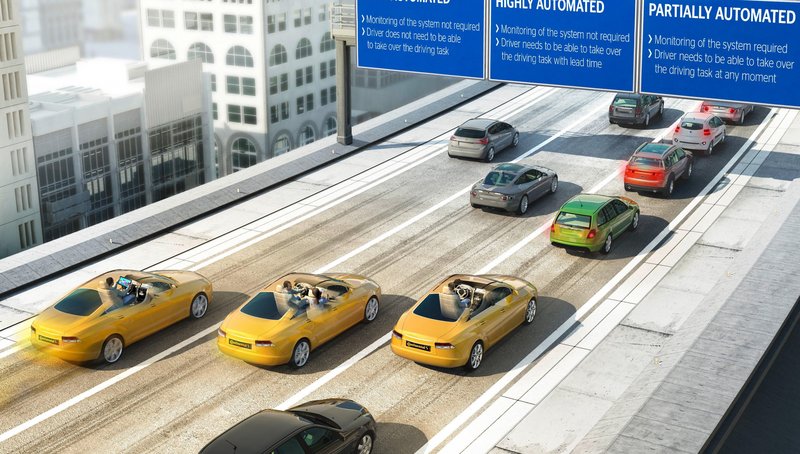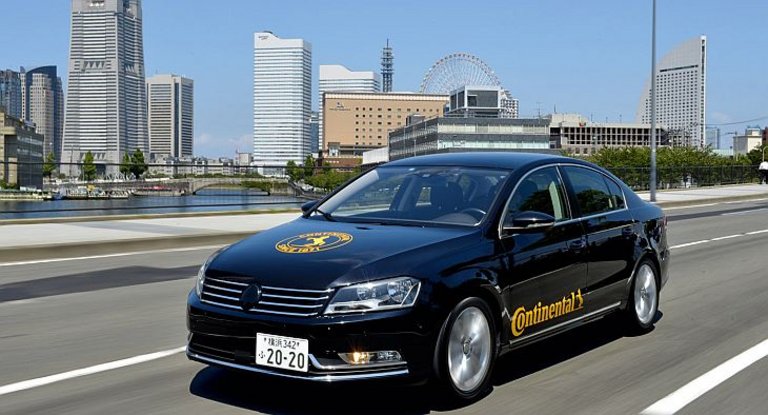In the future, who will be doing the driving, the driver or the car itself?
It is only a question of time until the car will be able to drive the driver around when desired. Because driving is not always fun – like when you are stuck in traffic or trying to parallel park in a tight space. In the next few years, it will become possible to gradually hand over more responsibility for driving to the car itself. The car of the future will therefore offer owners a completely new level of convenience and extra time that they can use as they wish – by catching a film or simply leaning back and relaxing while the car takes care of the driving.
Automated driving will add greater comfort to our mobility and help us to achieve other important goals: increased safety on the roads, improved traffic flow, and lower fuel consumption. Intelligent vehicle sensor systems used for automated driving allow the car to respond more quickly to traffic situations, naturally free of distractions, and to anticipate what is ahead better than our human instincts ever could. We can look forward to a future in which the car can become our chauffeur whenever we wish.
Does automated driving automatically mean more fun?
Alongside mobility and transport, the act of driving is about dynamism, passion, and enjoyment. In other words, the pleasure of driving. And drivers will still get this no matter what, because they always have the choice of whether and when to hand over certain functions to the vehicle and when they would prefer to take over control. Anyone who drives the same route every day or takes long, monotonous roads will be happy to let the vehicle take over.
So automated driving means that driving will always be pleasurable, regardless of whether you are driving yourself along an open freeway or allowing yourself to be driven because you have other things to do.
Everyone’s connected, so why not the car?
Today, vehicle surrounding sensors are already guaranteeing greater road traffic safety and better defensive driving. With digital foresightedness, vehicles of the future will be able to alert the driver to dangerous traffic situations in good time
For example, a driver would be informed about an oncoming traffic jam in time to do something about it. For this, we rely on vehicles being intelligently networked with their environment. The car sends information to the Internet and receives information from the Internet. It gathers data about traffic situations, the topography of the route, weather conditions and other road users and then analyzes it. The data is then made available to other vehicles, while the vehicle also uses the relevant information itself to assess the driving situation.
The car becomes part of the Internet – and anticipatory driving takes on a whole new meaning for future mobility.
We believe that automating the car will bring increased safety and greater freedom for the driver.
Who is testing automated driving before it is universally used?
Over 1,300 specialists at Continental are working on advanced driver assistance systems and the foundations of automated driving. In around 15 years, we have worked on over 100 driver assistance projects for automakers around the world. Since 2007, we have been committed to research projects for automated driving.
In 2012, in the U.S. state of Nevada, we successfully completed comprehensive tests comprising 15,000 miles of highly automated driving on public roads, without a single accident. For the first time ever, close-to-production technologies were used to monitor the vehicle’s surroundings and control it. This allows the vehicle electronics to detect the size and distance of obstacles and to electronically control both the brakes and the steering accordingly. The test vehicle was able to detect complex scenarios without any difficulty and lighten the driver’s workload with this level of automation.
Since November 2014, we have also been testing successfully on roads in Japan, where the test vehicle has already driven more than 5,000 kilometers. We pool our expertise at international development centers in for instance Frankfurt, Germany; Auburn Hills, U.S.A.; and Yokohama, Japan.
Together with our partners from the automotive industry, we will equip and test further trial vehicles with technologies that are nearly ready for production. In this way we are moving resolutely toward a new type of mobility, so that one day everyone will be able to experience the future.
How many more steps will it take before cars can drive themselves?
/ 2016
Partially automated driving starting in 2016 – assisting the driver in certain situations.
In the first step, it will be technically possible for partially automated systems to support drivers in stop-and-go traffic situations on the freeway traveling at up to 30 km/h. The car takes over steering as well. The driver is relieved of the physical and mental task of driving, but still needs to monitor the driving situation constantly.
/ 2020
Highly automated driving from 2020 – alternative use of the driver’s time.
In the next stage, which will be possible beginning in 2020, the driver will be able to hand over responsibility for driving on the freeway at varying speeds. For example, in slow-moving traffic, drivers can simply be chauffeured and turn their attention to another activity. They must however be able to resume control again at any time.
/ 2025
Fully automated driving from 2025 – comfort and convenience for the driver.
In the third stage, it will be possible to drive whole sections of a trip fully automatically. In other words, the vehicle would be able to be controlled automatically on the freeway at up to 130 km/h. When the car is in fully automated mode, drivers will no longer need to be able to take over, which will increase their freedom enormously and allow them to turn their travel time into leisure time.

